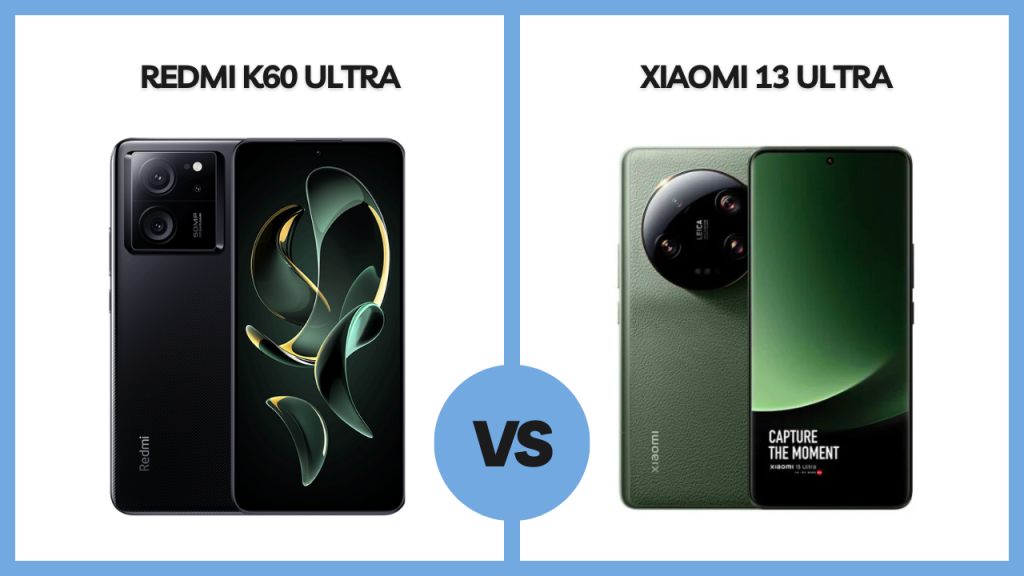The fight for dominance in the mid-to-high range segment is fierce in the current market, with both Xiaomi and its sub-brand Redmi launching flagships and flagship killers.

Redmi, Xiaomi’s sub-brand primarily known for budget-friendly smartphones, stepped up their game with the Redmi K60 Ultra this month, boasting premium features at a relatively affordable price. Xiaomi, on the other hand, came forth with their Xiaomi 13 Ultra, a testament to their continuous push towards innovation and cutting-edge technology.
Redmi K60 Ultra vs Xiaomi 13 Ultra
| Specification Categories | Redmi K60 Ultra | Xiaomi 13 Ultra |
|---|---|---|
| Dimensions & Weight | 162.2 x 75.7 x 8.5 mm, 204g | 163.2 x 74.6 x 9.1 mm, 227g |
| Display Type & Size | OLED 6.67 inches | LTPO AMOLED 6.73 inches |
| Resolution & PPI | 1220 x 2712 pixels, ~446 ppi | 1440 x 3200 pixels, ~522 ppi |
| CPU & GPU | Mediatek Dimensity 9200+, Immortalis-G715 MC11 | Qualcomm Snapdragon 8 Gen 2, Adreno 740 |
| RAM & Storage | Up to 1TB, 24GB RAM | Up to 1TB, 16GB RAM |
| Main Camera | Triple 50MP+8MP+2MP | Quad 50MP+50MP+50MP+50MP |
| Front Camera | 20 MP | 32 MP |
| Battery & Charging | 5000 mAh, 120W wired | 5000 mAh, 90W wired, 50W wireless |
Design
Table of Contents
With a sleek profile, the Redmi K60 Ultra sports a 162.2 x 75.7 x 8.5 mm dimension and weighs 204g. Available in colors like Black, White, and Green, its design stands out for those seeking a blend of elegance and functionality. Weighing slightly more at 227g, the Xiaomi 13 Ultra displays its premium style with Gorilla Glass Victus on the front, an eco-leather back, and an aluminum frame. With a more diverse color range, the 13 Ultra attracts a variety of users.
Display
The Redmi K60 Ultra brings forth a 6.67-inch OLED display, showcasing 68B colors and an impressive 144Hz refresh rate. With Dolby Vision and HDR10+, it promises vibrant visuals at any given time. The Xiaomi 13 Ultra steps it up slightly with a 6.73-inch LTPO AMOLED screen. With a higher resolution and pixel density, it guarantees crisper visuals.
Specs & Software
Both devices run on Android 13 with MIUI 14.
Redmi K60 Ultra is powered by Mediatek’s Dimensity 9200+ and Immortalis-G715 MC11 GPU and showcases impressive performance metrics for its segment. While the Xiaomi 13 Ultra runs on the Snapdragon 8 Gen 2 with Adreno 740 GPU, and provides top-tier performance, suited for power users.
Camera:
Redmi K60 Ultra comes with triple-camera setup, that boasts of a primary 50MP sensor complemented by an 8MP ultrawide and 2MP macro, catering to a majority of photographic needs. Xiaomi 13 Ultra features a quad-camera setup, all with 50MP sensors for wide, ultrawide, telephoto, and periscope telephoto ensuring that photography enthusiasts have a tool tailored to their needs.
Battery
The Redmi K60 Ultra has a 5000 mAh battery, much like the 13 Ultra, with an ultra-fast 120W charging, ensuring the phone is juiced up in record time. Xiaomi 13 Ultra, on the other hand, offers 90W of wired charging and an impressive 50W wireless charging feature.
Price:
Pricing often plays a pivotal role in the decision-making process of potential buyers.
The Redmi K60 Ultra is priced at about 330 EUR and is available internationally too via resellers. It’s a value proposition for those seeking premium features without breaking the bank. The Xiaomi 13 Ultra retails for around $899.00 and is available internationally via retailers like Giztop. It is clearly a higher-end model aimed at those seeking the very best.
Pros and Cons:
Redmi K60 Ultra vs Xiaomi 13 Ultra: PRO and CONS
Redmi K60 Ultra
PROS
- Value for money
- Ultra-fast 120W charging
- Vibrant 144Hz display
CONS
- Lacks quad-camera setup
- Limited color variants
Xiaomi 13 Ultra
PROS
- Quad 50MP camera setup
- Premium build and design
- Wireless charging
CONS
- Pricier segment
- Heavier build
Please note that the above comparison is based on specs. Check out our reviews of these devices for a better understand of how they perform in real life.




